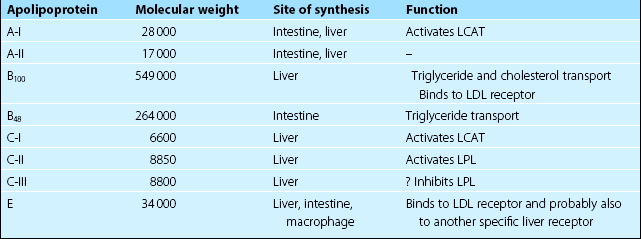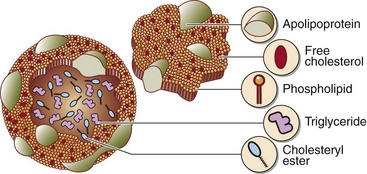66 The lipoprotein system evolved to solve the problem of transporting fats around the body in the aqueous environment of the plasma. A lipoprotein is a complex spherical structure that has a hydrophobic core wrapped in a hydrophilic coating (Fig 66.1). The core contains triglyceride and cholesteryl esters, while the surface contains phospholipid, free cholesterol and proteins – the apolipoproteins (Table 66.1). Cholesterol is an essential component of all cell membranes and is a precursor for steroid hormone and bile acid biosynthesis. Triglyceride is central to the storage and transport of energy within the body. Several different classes of lipoproteins exist whose structure and function are closely related. Apart from the largest species, the chylomicron, these are named according to their density, as they are most commonly isolated by ultracentrifugation. The four main lipoproteins and their functions are shown in Table 66.2. Table 66.2 The four main lipoproteins and their functions
Lipoprotein metabolism
Nomenclature
Lipoprotein
Main apolipoproteins
Function
Chylomicrons
B48, A-I, C-II, E
Largest lipoprotein. Synthesized by gut after a meal. Not present in normal fasting plasma. Main carrier of dietary triglyceride
Very low density lipoprotein (VDL)
B100, C-II, E
Synthesized in the liver. Main carrier of endogenously produced triglyceride
Low density lipoprotein (LDL)
B100
Generated from VLDL in the circulation. Main carrier of cholesterol
High density lipoprotein (HDL)
A-I, A-II
Smallest lipoprotein. Protective function. Takes cholesterol from extrahepatic tissues to the liver for excretion
Basicmedical Key
Fastest Basicmedical Insight Engine





